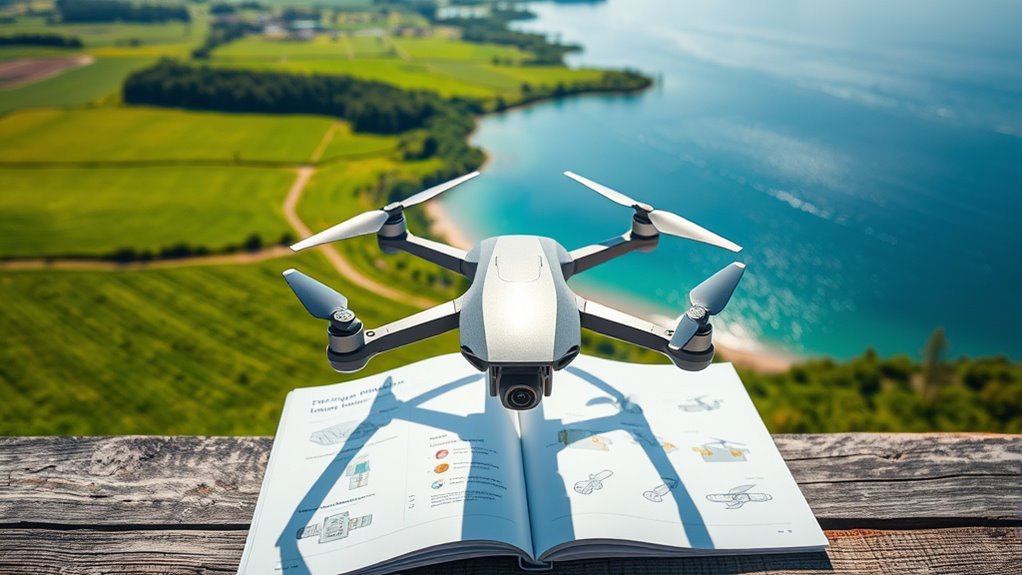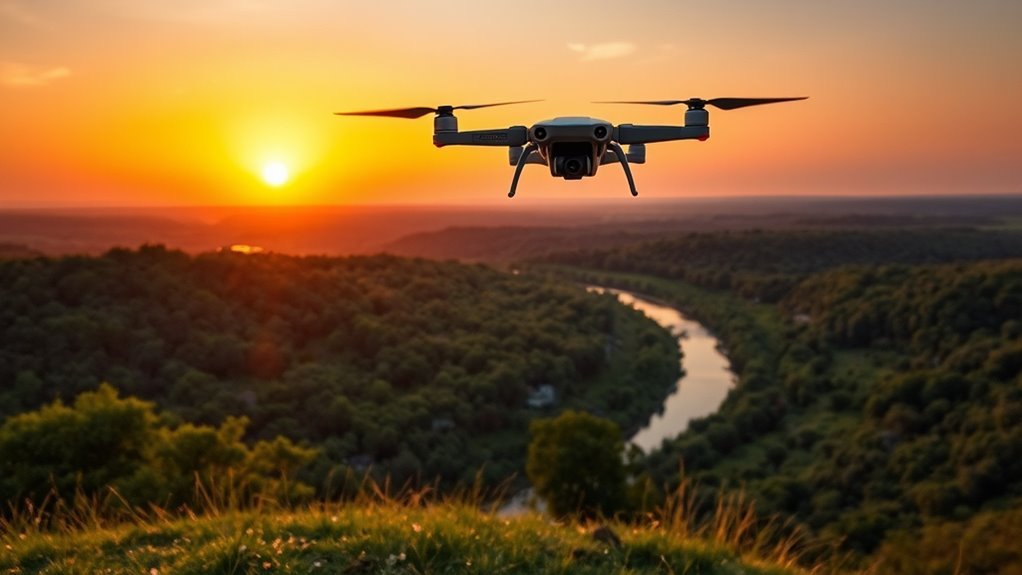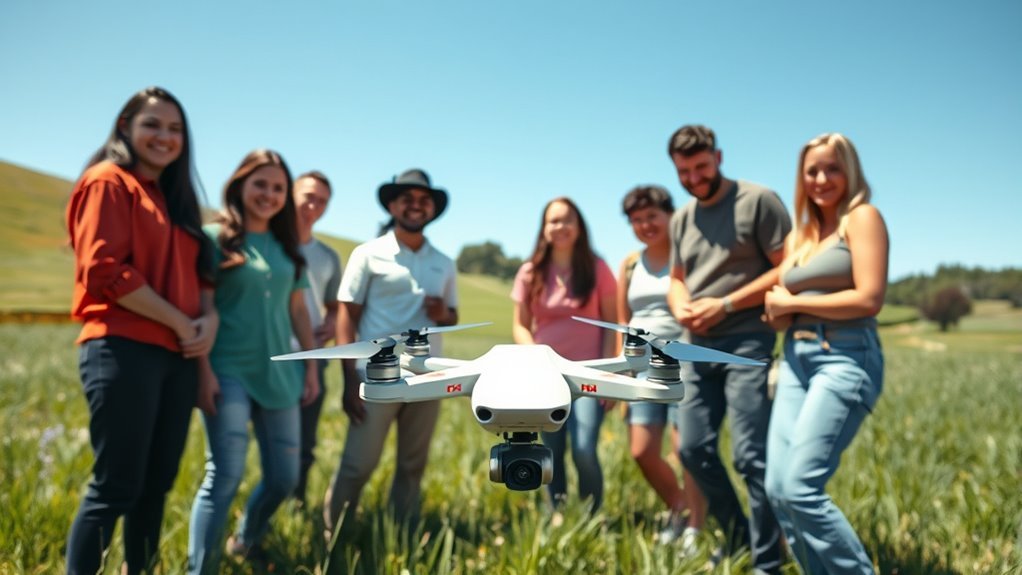Looking to fly a drone? Start by understanding the different types available and their features. Before takeoff, don’t forget to check your battery, inspect propellers, and calibrate the compass. Master the controls by practicing throttle adjustments and learning about flight modes. Stay informed about regulations and safety guidelines to guarantee a secure flying experience. Plus, you’ll capture stunning aerial footage with the right techniques. Continue exploring to uncover more tips and tricks for your drone adventures.
Understanding Drone Types and Features

When diving into the world of drones, it’s essential to understand the various types and features available—there are at least three main categories you should familiarize yourself with. First, you’ve got the consumer drones, ideal for beginners, often featuring user-friendly controls and basic camera capabilities. Next, consider racing drones, built for speed and agility, with advanced drone specifications that enhance maneuverability. Understanding aerodynamic design is crucial for those interested in maximizing speed, especially in racing drones. Finally, professional drones offer high-end camera capabilities, perfect for photography and videography enthusiasts. Each type serves a unique purpose, so think about your goals. Understanding these categories helps you choose the right drone, ensuring you’re equipped to explore the skies with freedom and confidence. For instance, the DJI Mini SE is a great example of a consumer drone that combines portability with impressive image clarity. Embrace this exciting journey and let your creativity soar!
Essential Pre-Flight Checks

Before you take to the skies, confirming your drone is ready for flight is vital to a successful experience. Start with a thorough battery check; a fully charged battery is imperative. Next, perform a propeller inspection to verify they’re secure and free of damage. Don’t skip compass calibration—it guarantees accurate navigation. Check for firmware updates to keep your drone performing at its best. A quick weather assessment is significant; avoid flying in high winds or rain, as these can drastically affect battery life. Utilize an equipment checklist to verify you’ve got all necessary gear. Finally, consider flight planning to map out your route, and make sure weight distribution is balanced to maintain stability. These essential pre-flight checks will set you up for a smooth, exhilarating flight. Additionally, ensuring that your drone is within regulatory restrictions will help avoid potential fines or legal issues during your flight.
Mastering the Controls

To fly your drone effectively, it’s essential to understand the controls and their functions. Each button and joystick plays a significant role in maneuvering, so take the time to familiarize yourself with them. Remember, practice makes perfect—frequent flying will enhance your skills and confidence in handling your drone. Additionally, understanding obstacle avoidance systems will help you navigate safely in tight or cluttered spaces. Moreover, being aware of flight stability can significantly improve your control during turbulent conditions.
Understanding Drone Controls
Mastering the controls of your drone is essential for a successful flight experience. To truly enjoy the freedom of flying, you’ll need to understand how to navigate the various controls effectively. Here are some key aspects to focus on:
- Control Sensitivity: Adjusting the sensitivity helps with precision in maneuvers.
- Flight Modes: Familiarize yourself with modes like GPS, Altitude Hold, and Manual for different flying conditions.
- Throttle Control: Practice gentle throttle adjustments for smooth ascents and descents.
- Yaw and Pitch: Learn how to control rotation and tilt to enhance your aerial shots.
Practice Makes Perfect
Once you’ve grasped the basics of drone controls, it’s time to put that knowledge into action. Engaging in regular drone practice is essential for honing your skills. Start in an open area, free from obstacles, allowing you to focus solely on maneuvering your drone. Experiment with different flight modes and speeds to understand how each affects control responsiveness. As you gain confidence, incorporate more complex maneuvers, like flips and precision landings. This skill development won’t just improve your flying; it’ll also enhance your ability to capture stunning aerial shots. Remember, the more you practice, the better you’ll become, revealing the true freedom that comes with flying. So, get out there and let the skies be your playground!
Learning Drone Regulations and Safety
While flying a drone can be an exhilarating experience, understanding the regulations and safety protocols is essential to ensuring a responsible flight. Ignoring drone laws can lead to serious consequences, not just for you, but for others too. Here are some key points to keep in mind:
- Always check local and national drone regulations.
- Maintain a visual line of sight with your drone.
- Avoid flying near airports or crowded areas, particularly in restricted airspace where safety is paramount.
- Follow safety guidelines to mitigate risks.
- Be aware that environmental conditions can impact radar detection capabilities, making it crucial to stay informed about your surroundings.
Best Practices for Capturing Aerial Footage
When capturing aerial footage, the angle you choose can dramatically impact the visual story you’re telling. You’ll also want to pay attention to lighting conditions, as they can enhance or diminish the quality of your shots. Mastering these elements will elevate your drone photography and videography skills. Additionally, understanding dynamic range will help you capture more vivid and lifelike images in varying lighting conditions. Using a 3-axis gimbal will further stabilize your footage, ensuring smoother and more professional-looking results.
Choosing the Right Angle
How do you decide on the perfect angle for your drone shots? Choosing the right angle can elevate your footage, capturing dynamic perspective variations that resonate with viewers. Here are some best practices to reflect upon:
- High Angle: Provides a sweeping overview, ideal for landscapes.
- Low Angle: Enhances the height of your subjects, adding drama.
- Side Angle: Adds depth and dimension, perfect for tracking movements.
- Dutch Angle: Creates a sense of unease or excitement, great for storytelling.
Experimenting with these best camera angles can transform ordinary scenes into enchanting visuals. Remember, the freedom to explore different perspectives is what makes aerial photography thrilling. So, don’t hesitate to get creative and find angles that truly reflect your vision!
Lighting Conditions Matter
Capturing stunning aerial footage isn’t just about choosing the right angle; lighting conditions play a pivotal role in determining the quality and mood of your shots. To make the most of your drone’s capabilities, you’ll want to employ effective lighting techniques. The golden hour—shortly after sunrise or before sunset—is often the most ideal time for vibrant colors and soft shadows. Midday sun can create harsh contrasts, washing out details. To enhance your footage, consider using filters that reduce glare and enhance color saturation. Always pay attention to the direction of light; shooting with the sun behind you often yields the best results. By understanding these principles, you can elevate your aerial photography to new heights.
Troubleshooting Common Issues
While flying a drone can be exhilarating, you might encounter some common issues that can disrupt your experience. Here’s how to tackle them effectively:
- Battery Issues: Confirm your battery’s charged and check for any swelling or damage. Remember that drone registration is also important for ensuring compliance and safety while flying.
- Signal Interference: Fly away from Wi-Fi routers and other electronic devices to minimize disruptions.
- Camera Malfunctions: Restart the drone and check for lens obstructions or software updates.
- GPS Inaccuracies: Recalibrate your drone and confirm you’re in an open area for better satellite connection.
Pay attention to propeller damage, overheating concerns, and calibration problems. Additionally, ensure your drone is suitable for the environmental conditions you are flying in, as factors like wind and temperature can affect performance. A little troubleshooting can restore your freedom in the sky and keep your flights smooth!
Resources for Continued Learning
As you dive deeper into the world of drone flying, accessing quality resources can greatly enhance your skills and knowledge. To elevate your expertise, consider leveraging online courses that focus on advanced techniques and safety protocols. Community forums are also invaluable, where you can exchange tips and experiences with fellow drone enthusiasts. Additionally, familiarizing yourself with safety features is essential for a secure flying experience. Understanding the integration of AI and autonomous systems will also significantly improve your operational efficiency and overall drone experience.
| Resources | Description |
|---|---|
| Online Courses | Structured learning on advanced flying skills, regulations, and maintenance. |
| Community Forums | Platforms to ask questions, share experiences, and gain insights from others. |
| YouTube Channels | Visual tutorials and reviews that cover various aspects of drone operation. |
Utilizing these resources will empower you to fly confidently and creatively, revealing the full potential of your drone adventures.
Frequently Asked Questions
What Is the Average Flight Time for Most Drones?
Most drones have an average flight time of 20 to 30 minutes, depending on their efficiency. Understanding your drone’s battery life can help you plan and maximize your flying experience for ultimate freedom in the skies.
Can I Fly a Drone Indoors?
Did you know that nearly 30% of drone accidents occur indoors? You can fly a drone indoors, but always take safety precautions, like ensuring there’s enough space and avoiding obstacles to enjoy a safer flying experience.
How Do I Maintain My Drone?
To maintain your drone, regularly clean it to prevent debris buildup, and always check for damages. Don’t forget battery care—charge it properly and store it in a cool, dry place for ideal performance.
What Accessories Do I Need for My Drone?
You’d think flying a drone is all about freedom, but it’s actually about having the right gear. Grab quality drone cameras, extra battery packs, and protective cases to release your aerial adventures fully.
Are There Any Age Restrictions for Flying Drones?
Yes, there are age requirements for flying drones. Most legal regulations state you must be at least 13 years old to operate a drone registered with the FAA. Check local laws for specifics in your area.

